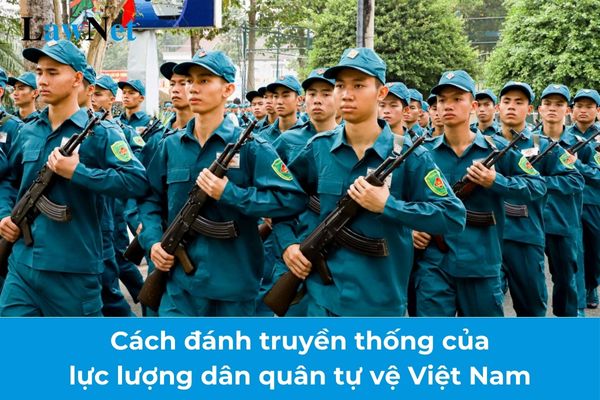What is the traditional combat method of the Militia and Self-Defense Force in Vietnam? What are the requirements for upper secondary school students' awareness of national defense and security?
What is the traditional combat method of the Militia and Self-Defense Force in Vietnam?
The traditional combat method of the Militia and Self-Defense Force in Vietnam is guerilla warfare, a tactic built on the elements of surprise, flexibility, and creativity. This tactic focuses on the principles of “using the small to defeat the large” and “using the few to defeat the many”, by maximizing the use of natural terrain and the unique conditions of the country.
During the wars of resistance against foreign invasion, the Militia and Self-Defense Force often organized surprise ambush and assault operations at times and locations unexpected by the opponent, aiming to deplete enemy forces and destroy their logistical bases and war equipment.
Instead of facing direct confrontation, we choose to disperse our forces, evade when necessary, and concentrate attacks when opportunities arise, creating a flexible and unpredictable battlefield. This approach not only helps preserve forces but also effectively weakens the enemy, contributing to the remarkable victories in the nation's history.
The Militia and Self-Defense Force is an important component of the People's Armed Forces of Vietnam, closely linked with the populace and widely organized from villages, wards, and commune-level towns (militias) to agencies and enterprises (self-defense units). This force has a long history, formed and developed through the process of fighting to protect national independence.
During the resistance against the French, the Militia and Self-Defense Force cooperated with main military forces to secure significant victories, such as the Dien Bien Phu campaign, where ambushes along enemy supply lines contributed to weakening the logistical system of the opponent.
In the resistance against the Americans, the Militia and Self-Defense Force continued to play its role by organizing small, yet effective, battles to disrupt enemy supply lines, depots, and military bases, significantly reducing their combat strength.
Today, the Militia and Self-Defense Force continues to play a pivotal role in the national defense of all people, protecting local security and order. They not only participate in defense but also contribute to disaster prevention, rescue, and recovery efforts in response to disasters and epidemics. Upholding the traditions of patriotism, ingenuity, and creativity, the Militia and Self-Defense Force is constantly being strengthened and developed, becoming an indispensable part of the cause of building and defending the nation, and maintaining sovereignty, peace, and stability for the country.
Note: The above content is intended for reference only.

What is the traditional combat method of the Militia and Self-Defense Force in Vietnam? What are the requirements for upper secondary school students' awareness of national defense and security in Vietnam? (Image from the Internet)
What are the What are the requirements for upper secondary school students' awareness of national defense and security in Vietnam?
Under subsection 2, Section 4 of the National Defense and Security Education curricula at the upper secondary level issued with Circular 46/2020/TT-BGDDT, the requirements for students' awareness of national defense and security are as follows:
- Present the roles and duties of national defense and security in building and defending the Socialist Republic of Vietnam; the history and traditions of the Vietnamese People's Armed Forces in the cause of building and defending the nation throughout history;
- State the legal provisions regarding the duties of the people's national defense, public security; the responsibilities of citizens in implementing legal regulations;
- Analyze and present fundamental issues concerning territorial sovereignty, national borders; the responsibilities of citizens in protecting the national territorial sovereignty and borders today;
- State the basic content of the Law on National Defense and Security Education, the Law on Officers of the Vietnam People's Army, the Law on the People's Police, the Law on Military Service, the Law on Road Traffic, the Law on Environmental Protection, the Law on Cybersecurity, etc.; know how to prevent various types of crime and social evils; legal provisions on social evils and citizens’ responsibilities in crime and social evil prevention, both inside and outside of school;
- Present the basic skills in military discipline; infantry combat techniques, infantry tactics; how to use the AK submachine gun, and grenades; auxiliary tools and their usage, as well as scenarios for using such tools;
- State the content concerning civil defense, prevention of bombs, mines, chemical, biological, high-tech weapons, natural disasters, epidemics, and fires...; skills in observing, listening, detecting the enemy, designating targets, transmitting communications, reporting; know-how to find and maintain direction, exploit terrain and terrain features and apply individual technique and tactics in practicing military skills.
What are the 05 topics of the National Defense and Security Education curricula at the upper secondary level in Vietnam?
Under subsection 1, Section 5 of the curriculum for National Defense and Security Education at the upper secondary level issued with Circular 46/2020/TT-BGDDT, the 05 topics of the National Defense and Security Education curricula at the upper secondary level in Vietnam are as follows:
(1) Some general knowledge about national defense and security;
(2) Military discipline regulations;
(3) Infantry combat techniques;
(4) Infantry tactics;
(5) Some knowledge about civil defense and general knowledge of people's air defense.

